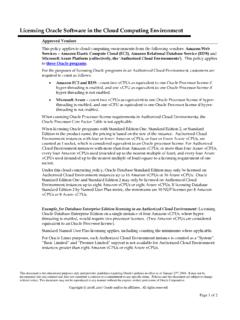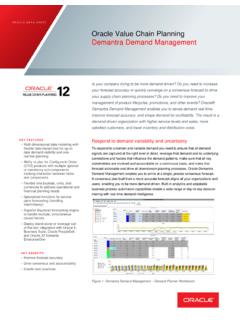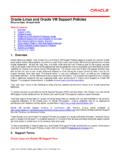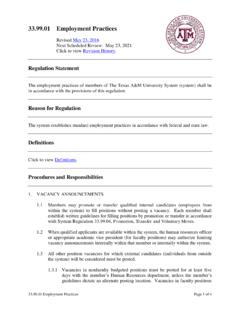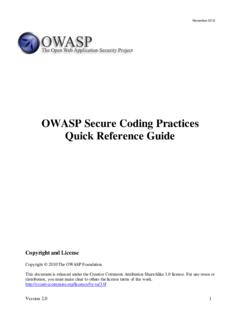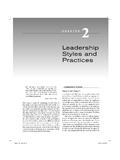Transcription of OCFS2 Best Practices Guide - Oracle
1 An Oracle White Paper February 2014. OCFS2 best Practices Guide OCFS2 best Practices Guide Introduction .. 1! OCFS2 Overview .. 2! OCFS2 as a General File System .. 3! OCFS2 and Oracle RAC .. 9! OCFS2 with Oracle VM .. 9! OCFS2 Troubleshooting .. 10! Troubleshooting Issues in the Cluster .. 13! OCFS2 : Tuning and 21! Summary .. 23! Additional Resources .. 24! OCFS2 best Practices Guide Introduction OCFS2 is a high performance, high availability, POSIX compliant general-purpose file system for Linux. It is a versatile clustered file system that can be used with applications that are non- cluster aware and cluster aware. OCFS2 is fully integrated into the mainline Linux kernel as of 2006 and is available for most Linux distributions. In addition, OCFS2 is embedded in Oracle VM and can be used with Oracle products such as the Oracle Database and Oracle RAC. solutions. OCFS2 is a useful clustered file system that has many general purpose uses beyond Oracle workloads.
2 Utilizing shared storage, it can be used for many general computing tasks where shared clustered storage is required. Its high performance and clustering capabilities set it apart from many other network based storage technologies. Cluster aware applications can take advantage of cache-coherent parallel I/O from more than one node at a time to provide better performance and scalability. Uses for OCFS2 are virtually unlimited, but some examples are a shared file system for web applications, database data files, and storing virtual machine images for different types of open source hypervisors. OCFS2 is completely architecture and endian neutral and supports file system cluster sizes from 4KB to 1MB and block sizes from 512 bytes to 4KB. It also supports a number of different features such as POSIX ACL's, Indexed Directories, REFLINK, Metadata Checksums, Extended Attributes, Allocation Reservation and User and Group Quotas 1.
3 OCFS2 best Practices Guide OCFS2 Overview Clustering is the concept of connecting multiple servers together to act as a single system, providing additional resources for workloads and failover capabilities for high availability. Clustered systems frequently use a heartbeat to maintain services within the cluster. A heartbeat provides information . such as membership and resource information to the nodes within the cluster and can be used to alert nodes of potential failures. Clustered systems typically are designed to share network and disk resources and communicate with one another using a node heartbeat to maintain services within the cluster. Clustered systems often contain code that will detect a non-responsive node and remove it from the cluster to preserve the ability to continue its services and avoid failure or data corruption. OCFS2 utilizes both a network and disk based heartbeat to determine if nodes inside the cluster are available.
4 If a node fails to respond, the other nodes in the cluster are able to continue operation by removing the node from the cluster. The following diagram shows the functional overview of a three node OCFS2 cluster. The private network interconnect is shown in red and the shared storage interconnect is shown in gray. The shared storage in this example could be Fibre Channel, iSCSI or another type of storage that allows multiple nodes to attach to a storage device. Each node has access to the shared storage and is able to communicate with other nodes using the private network interconnect. In the event that a node is unable to communicate via the network or the shared storage, the node will be fenced, which means it will be evicted from the cluster and the kernel panics in order to return to an operational state. Figure 1. Functional Overview of a Three Node OCFS2 Cluster OCFS2 's disk-based heartbeat works in the following way.
5 Each node writes to its block in the system heartbeat file every two seconds. Nodes will communicate to each node in the cluster with a TCP. keepalive packet on port 7777 every two seconds to determine if the node is alive. The nodes in the cluster will read the blocks written by other nodes on disk every 2 seconds and if the timestamps on 2. OCFS2 best Practices Guide the blocks of the other nodes are changing, those nodes are considered alive. If there is no response, the time-out timer starts and will mark the node as not responding when the timeout value is reached. OCFS2 uses the network in addition to a separate disk based heartbeat to determine if nodes are alive and for communication of file locks and file system access. Once a node stops responding on the network and all the timers have expired, the quorum call is performed. When nodes lose connection via the network they are in split brain mode as they communicate via the disk heartbeat but not on the network heartbeat.
6 This situation results in a temporary hang. To recover, some of the disconnected nodes have to be evicted. This decision is made by the quorum code. The quorum code acts with the following logic: if there are 2 nodes in a cluster and they lose connection with each other, the node with the lowest node number survives. In case of more than 2 nodes, a node survives if it can communicate with more than half the nodes in the cluster. If the node communicates with half the nodes, a node will survive if it can communicate to the lowest node number. During a network timeout situation the nodes can still determine node functionality and perform quorum calls using the disk heartbeat. best Practices for setup and installation vary depending on the intended purpose. Specific installation guides can be found in the additional resources section of this document. For the purpose of this Guide , examples will cover some of the basic configuration and best Practices for installing and configuring OCFS2 for general file system usage and differences when using OCFS2 with other products, such as Oracle RAC and Oracle VM.
7 It is recommended that readers refer to the OCFS2 . Users Guide for additional details not covered in this document. OCFS2 as a General File System Although the amount of traffic generated by OCFS2 's network heartbeat process is low, the heartbeats are critical to operation thus it is recommended that a dedicated network interface be used for the network interconnect. Optimally this dedicated network interface should be on a private network or VLAN that only the nodes in the cluster have access to. This will allow the cluster's network traffic to have better access and less latency without competing with other network traffic. For example, a node that was accessing an OCFS2 file system and was used as a file server would have the file transfer competing with the cluster's network traffic. This latency could cause the node to be removed from the cluster if it did not respond to the keep alive packets in the allotted time out values.
8 Dedicated network interfaces also make the process of troubleshooting easier as you can look at the traffic on the dedicated interface without other traffic being seen in your packet capture. It is important that all nodes that will access the file system have read and write access to the storage being used to store the file system. For SAN and iSCSI based storage access, multi-pathed disk volumes are highly recommended for redundancy. This will protect against the individual nodes losing access to the storage in the event of a path failure. Optimally this should be done on redundant switches in the event of a switch failure causing the path failure. Complete configuration of / should be completed before the configuration of the file system. Further resources for configuring multipathd can be found in the additional resources section of this document. 3. OCFS2 best Practices Guide When designing your OCFS2 file system it is important to keep in mind the number of nodes that you select for your cluster.
9 Two node clusters are not optimal because of the possibility of both nodes self fencing and causing a completely offline file system. When there is a connectivity failure, there's a 50/50 chance that the node that is still alive has a higher node number. This can cause both systems to become unavailable. It is also important to keep in mind the possibility for expansion in the future for your cluster if you decide to add additional nodes. When formatting the file system, it is important to consider additional node slots for expansion as when node slots are added after the fact they can cause performance related issues with the file system at a later date. Additional node slots do consume some additional disk space but have no performance impact on the file system. It is important to note with later releases of OCFS2 the graphical ocfs2console utility has been removed. Configuration of the /etc/ OCFS2 file can be done manually but the recommended option is using the o2cb cluster registration utility for the o2cb cluster stack.
10 The use of the o2cb cluster registration utility is preferred to avoid mistakes in editing the /etc/ OCFS2 file as formatting errors can cause problems. The following is an example of a working /etc/ OCFS2 file for a 3 node OCFS2 cluster: node: name = OCFS2 -1. cluster = ocfs2demo number = 1. ip_address = ip_port = 7777. node: name = OCFS2 -2. cluster = ocfs2demo number = 2. ip_address = ip_port = 7777. node: name = OCFS2 -3. cluster = ocfs2demo number = 3. ip_address = ip_port = 7777. cluster: name = ocfs2demo heartbeat_mode = local node_count = 3. 4. OCFS2 best Practices Guide Here are the configuration options for the /etc/ OCFS2 file: node This section defines the configuration for a node in the cluster. This is one of the systems in the cluster. Name This defines the hostname of the system. Cluster This defines the cluster that the system is a member of. Number This defines the node number of the system. Each system needs a unique node number.
